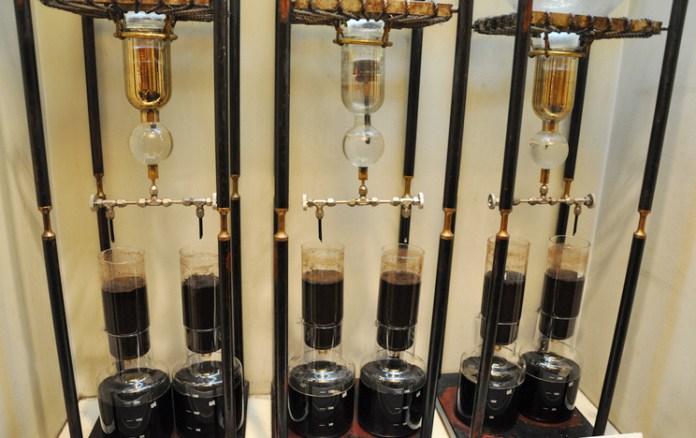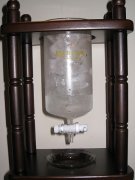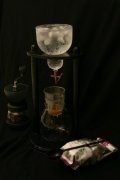The invention and history of ice drop coffee extraction principle of ice drop coffee pot steps for making ice drop coffee

Professional coffee knowledge exchange more coffee bean information please follow the coffee workshop (Wechat official account cafe_style)
Do you understand cold extract, ice brew, ice drop and Japanese iced coffee?
Do you wonder where the ice drop coffee (cold drip coffee) comes from? In fact, ice drop coffee has a very long history, and it was invented much older than hand-brewed coffee and Italian coffee, and the historical story behind it is also quite complicated. And today Goat Coffee will unravel the mystery of the history of ice drop coffee.
Ice drop coffee, ice brewed coffee and Dutch coffee
First of all, you have to figure out the difference between three terms: iced coffee (Cold drip coffee), iced coffee (Cold brew coffee) and Dutch coffee (Dutch Coffee). To put it simply, Dutch coffee is a general term. Both ice-drop coffee and ice-brewed coffee belong to the way of making Dutch coffee, which is also rooted in Dutch coffee. Dutch coffee is defined as brewing coffee powder in cold water.
Diagram of Holland, Ice drop and Ice-brewed Coffee
1. Dutch Coffee (Dutch Coffee)
It is a general term, as long as the coffee powder is soaked in cold water to extract the coffee liquid, it is called Dutch coffee.
two。 Ice drop Coffee (Cold drip coffee)
Ice drop coffee is to use the ice drop cover set with the upper, middle and lower pots to place ice cubes in the upper pot and coffee powder in the middle pot, waiting for the melted ice water to pass through the coffee powder in the middle pot, and the coffee liquid is extracted and leaked into the lower pot. A kind of Dutch coffee.
For details, see the steps for making ice drop coffee.
Ice drop coffee pot group
3. Ice brewed coffee (Cold brew coffee)
The so-called ice-brewed coffee is a new way of making coffee that is quite popular in Europe and the United States in recent years. Ice water is poured directly into a sealed container containing coffee powder, and then the coffee powder and coffee grounds are filtered out after waiting for 12muri for 24 hours. Ice-brewed coffee has a strong sweet and alcoholic taste, and its sour taste is stronger than that of ice-drop coffee. Because it also uses ice water to brew coffee powder, it also belongs to Dutch coffee.
The invention of Dutch coffee
The exact inventor of Dutch coffee can no longer be tested, but according to the latest research in the foreign coffee industry, the brewing method of this kind of coffee was invented by Dutch businessmen who went to Batavia, Indonesia.
Dutch businessman
Around 1699, the coffee plant was brought to Batavia, Indonesia, by Dutch merchants, who hoped to make considerable economic profits through massive cultivation in the colonies. This group of Dutch businessmen are also fascinated by coffee, a magical drink. However, the dangerous and long voyage on the sea leaves them no time to make coffee. As a result, Dutch businessmen wondered if there was any way to preserve coffee for a long time, because the coffee liquid brewed in hot water was not easy to preserve because it contained a lot of oil.
Dutch trading merchant ship
As a result, Dutch coffee, which uses ice water to soak coffee powder to obtain coffee liquid, was born, and the exact time of its invention can no longer be determined, but it is speculated to be in the early 18th century, that is, about 300 years ago. Dutch businessmen have found that coffee made by this method can be preserved for a long time not only because it is free of oil, but also can be traded and drunk at sea. What is even more surprising to them is that the coffee made by this method is not bitter at all. It is unusually sweet and has a different flavor.
What is puzzling is that it may be too far away, but the way Dutch coffee is made has never been transmitted back to Holland. on the contrary, with the trade footprint of Dutch businessmen, it spread to the shogunate of the Edo era and was very popular with the Japanese.
The Japanese depiction of the Dutch
This way of making coffee was lost in other places in the future, only in Japan, and gradually evolved into today's ice drop cover group, with three pots.
Therefore, it is no wonder that many people mistakenly believe that iced coffee was invented by the Japanese. In fact, the Japanese only improved the production method invented by the Dutch at that time. However, the Japanese have played an important role in the preservation of this way of production, and if they had not retained this technology, you and I would not have had the special sweet flavor of iced coffee.
With the rise of the third wave of coffee from Japan at the beginning of this century, the technology of hand-made coffee and iced coffee has also spread from Japan to all parts of the world. Coffee shops in Europe and the United States that boast high-quality coffee seem to be out of date if they do not sell coffee from these two processes. Interestingly, Dutch coffee finally spread back to the Netherlands with this wave, only 300 years later. The history of coffee and coffee in history are always full of coincidences and adventures.
.
Important Notice :
前街咖啡 FrontStreet Coffee has moved to new addredd:
FrontStreet Coffee Address: 315,Donghua East Road,GuangZhou
Tel:020 38364473
- Prev

Ice drop coffee how to drink ice drop coffee to make ice drop coffee no matter how cold it is in winter, you should drink ice drop coffee!
Professional coffee knowledge exchange more coffee bean information please follow the coffee workshop (Wechat official account cafe_style) cold extract, ice brew, ice drop, Japanese iced coffee, do you understand? Recently, my friends often ask me, do you still drink iced coffee in winter?. Right。 Or drink iced coffee. I replied: no matter how cold it is, I still drink it. The instructions for the ice drop coffee maker, of course.
- Next

Assemble your own ice-drop coffee pot and make ice-drop coffee at home. How much is this ice-drop coffee per cup?
Professional coffee knowledge exchange more coffee bean information please follow the coffee workshop (Wechat official account cafe_style) cold extract, ice brew, ice drop, Japanese iced coffee, do you understand? If you make your own iced coffee, you can also drink the mellowness of time at home! Most of the people who will start to try iced coffee have accumulated some coffee tasting experience. Different from hot water extraction or
Related
- Beginners will see the "Coffee pull flower" guide!
- What is the difference between ice blog purified milk and ordinary milk coffee?
- Why is the Philippines the largest producer of crops in Liberia?
- For coffee extraction, should the fine powder be retained?
- How does extracted espresso fill pressed powder? How much strength does it take to press the powder?
- How to make jasmine cold extract coffee? Is the jasmine + latte good?
- Will this little toy really make the coffee taste better? How does Lily Drip affect coffee extraction?
- Will the action of slapping the filter cup also affect coffee extraction?
- What's the difference between powder-to-water ratio and powder-to-liquid ratio?
- What is the Ethiopian local species? What does it have to do with Heirloom native species?

